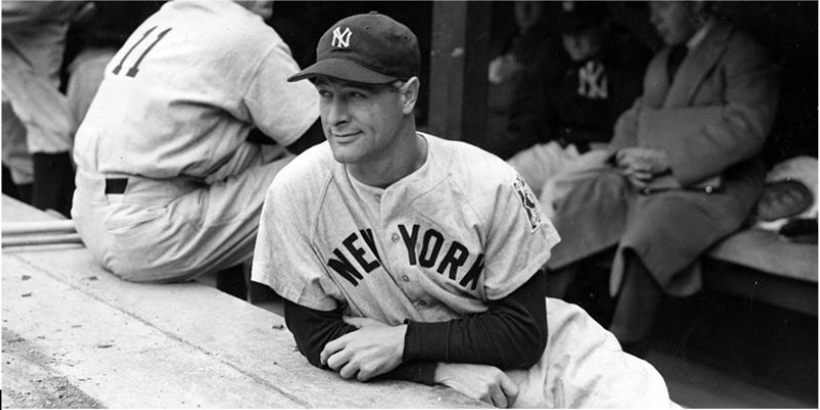
Emotion is the key when it comes to engaging an audience. Surprisingly, an American baseball legend offers one of the best examples of how to use emotion as a speaker.
We admire sportspeople for their athletic exploits. It’s even fair to say that great athletes can inspire others to do amazing things. After all, they push the boundaries of physical achievement and show us what’s possible with our own bodies.
In this way, a great athlete can be an influencer.
However, athletes typically aren’t the first people most think about when they consider great speakers. Most athletes limit their verbal contributions to interviews and the occasional talk show.
That makes it all the more surprising that it is an athlete who offers one of the best examples of using emotion to engage an audience when speaking.
In 1939, Lou Gehrig stood on a baseball field and delivered one of the most moving speeches of the 20th century.
This article will highlight some of the lessons that speakers can take from that speech. But first, let’s find out a little bit more about who Lou Gehrig was.
Who Was Lou Gehrig?
Born in New York in 1903, Lou Gehrig was the son of German immigrants who’d only arrived in the United States a couple of days prior.
He grew up in abject poverty. None of his three siblings survived through infancy and his father was an alcoholic. However, his mother was a hard worker who constantly pushed her son to educate himself.
And it was during his schooling that Gehrig began to show a talent for physical activities. In particular, he had a gift for baseball that none of his fellow students could rival.
Gehrig graduated high school and began studying at Columbia University. There, he starred for both the football and baseball teams. His batting ability drew the attention of the New York Yankees, who signed him to a professional contract in 1923.
Thus began the career of a baseball legend. Gehrig went on to play 2,130 consecutive games for the Yankees. Along the way, he won many championships and enjoyed a career that made him a shoo-in for the Hall of Fame.
Unfortunately, his performances began to suffer during the 1938 season. Perturbed by this sudden drop in his abilities, Gehrig checked himself into the Mayo Clinic for testing.
It was here that he discovered that he had amyotrophic lateral sclerosis (ALS).
The condition forced an immediate retirement from the field. In front of the fans that had cheered him on for over a decade, Gehrig delivered an impactful retirement speech.
His farewell to baseball offers so much that speakers can bring to their own work. Here are four lessons for you to take away from it.

Lesson #1 – Showcase Your Vulnerability to Engage Your Audience
During his playing career, Gehrig earned the nickname of “The Iron Horse”. A consistently strong presence, he was a player who approached every game with a powerful resolve.
He showcases that iron resolve during his speech. But for the first time, fans got a bit more of a glimpse into the man behind the baseball exploits.
Gehrig’s farewell to baseball is a speech that’s loaded with vulnerability. It’s clear that the ALS diagnosis has devastated Gehrig. What’s also clear is that he’ll miss doing what he has loved doing for his entire life.
And yet, he maintains a positive outlook throughout the speech. Though he now faces a challenge that’s taken away something that he loves, he’s not going to allow it to grind him down.
His bittersweet closing line showcases this sentiment perfectly:
“So, I close in saying that I might have been given a bad break, but I’ve got an awful lot to live for.”
With this simple line, Gehrig confronts his own vulnerability. He puts it out in the open for all to see before making it clear that his diagnosis would not prevent him from enjoying his life.
That’s one of the reasons why his audience connected with him during his speech. Many had grown to idolise him for his playing abilities. But in showcasing his vulnerability, Gehrig gave the audience a reason to care about him as more than just a player.
You should do the same. Your audience obviously cares about the results that you can deliver. But if that’s all they care about, you’re not going to engage them. By showing them a little more of who you are, as well as what you offer, you encourage the listener to invest in you as a person.
Lesson #2 – Don’t Say More Than You Need to
Gehrig was not a man who felt at home speaking in front of an audience. In fact, most knew him as a fairly quiet individual. Where many of his compatriots courted the media spotlight, Gehrig preferred to just get on with the job at hand.
This discomfort with being in the public eye would have become apparent if Gehrig attempted to give a long-winded speech.
However, he recognised that he had a simple message to deliver. And he took just under 280 words to say what he needed to say. That amounted to little more than a couple of minutes spent in front of the microphone.
As a professional speaker, you’re obviously more comfortable in front of an audience than Gehrig was. However, the shortness of his speech still teaches you a vital lesson.
Do not say more than you need to.
We live in a world where there are hundreds of things vying for our attention. As an influencer, you need to make the maximum impact in the shortest possible time to engage your audience.
That means trimming your speeches so that you don’t spend too long belabouring points. Keep it short and only say what you need to say. Don’t waste your time on the fluff that might make somebody disengage from what you’re saying.
Lesson #3 – Use Questions to Relate to Your Audience
The key thread of luck ran through Gehrig’s speech. We’ll cover that in more detail below. What’s key here is that Gehrig didn’t want his audience to feel sorry for him. He wanted to make it clear that he still had a lot to live for even with his diagnosis.
To do that, he used the power of rhetorical questions to subtly influence his audience. Throughout his short speech, he asked several questions that he used to showcase how much his career had given to him.
Examples include the following:
“Look at these grand men. Which of you wouldn’t consider it the highlight of his career just to associate with them for even one day?”
And:
“Who wouldn’t consider it an honour to have known Jacob Ruppert? Also, the builder of baseball’s greatest empire, Ed Barrow? To have spent six years with that wonderful little fellow, Miller Huggins? Then to have spent the next nine years with that outstanding leader, that smart student of psychology, the best manager in baseball today, Joe McCarthy?”
Here, Gehrig pays homage to the people who helped to shape his career while also relating to his audience.
He uses rhetorical questions to put them in his position and influence them not to feel sorry for him. Instead, he wants them to celebrate his career rather than think of his condition.
Gehrig’s essentially saying that he’s a fan first, which establishes an instant connection with his audience. He also highlights how powerful rhetorical questions can be as a means of subtly influencing an audience’s mood.
Lesson #4 – Repeat Your Key Thread
At Speakers Institute, we often talk about the importance of having a key thread.
In Gehrig’s case, luck was the thread. He made it clear throughout his speech that he considered himself one of the luckiest men alive.
Take his opening line as an example:
“Fans, for the past two weeks you have been reading about a bad break I got. Yet today I consider myself the luckiest man on the face of the earth.”
He goes on to talk about the great people he’s met in the game. And he punctuates each passage with the same phrase:
“Sure, I’m lucky.”
Even in closing, he maintains this key thread when speaking about his family.
As mentioned, Gehrig wanted people to remember his career rather than his condition. By establishing the key thread early and revisiting it throughout his speech, he put it at the top of the audience’s mind.
You should do the same with your key thread. Figure out what it is and revisit it repeatedly during your speech. The aim is to drill that main idea into the listener’s mind so that they take it away with them when you stop speaking.

The Final Word
Lou Gehrig shows us that speakers can take inspiration from so many different people. While he was an athlete who didn’t feel comfortable under the spotlight, Gehrig still gave a passionate retirement speech.
He showcased his vulnerability, only spoke for as long as he needed to, and established a key thread. These are all things that great storyshowers do.
Speakers Institute can help you put the lessons from this speech into practice.
Just follow these steps to give your speaking career a boost:
-
Head to GREENROOM. The #1 Online Hub connecting you to the world’s leading Influencers, Training and Curriculum.
-
For information on dates and times of our live events, just go here: LIVE EVENTS.